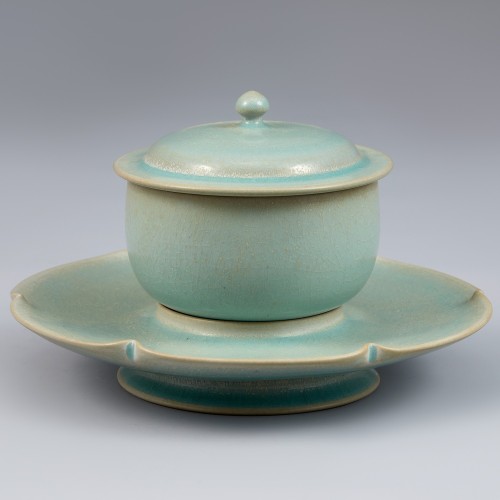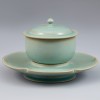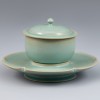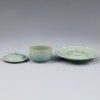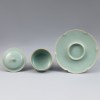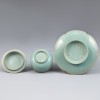본문
이 유물은 북송대(北宋, 960-1127) 여요(汝窯)에서 제작된 뚜껑 있는 잔과 꽃잎 모양 받침대로 구성된 잔탁입니다. 차(茶) 혹은 술(酒)을 담는 제기 용도로 추정되며, 여요 특유의 단정한 기형과 은은한 색조, 표면의 세밀한 균열문(開片)을 모두 갖춘 점에서 기품이 느껴집니다.
전체적으로 뚜껑(蓋), 본체(盒), 받침(托)의 세 부분으로 구성되어 있으며, 뚜껑은 꼭지 손잡이가 달린 둥근 형태로 본체 위를 안정감 있게 덮고 있습니다. 본체는 단정한 반구형이며, 이를 받치는 잔탁은 여섯 장의 꽃잎 형태(花形)로 제작되어 이 유물만의 미감을 보여줍니다. 받침 중앙에는 본체가 고정되도록 원형 받침 턱이 있으며, 전체적인 비례감과 조형미는 여요의 격조 높은 미학을 반영하고 있습니다.
겉면에는 전면적으로 담청색(淡靑色) 유약이 곱게 시유되어 있으며, 자연스레 형성된 균열문(開片)이 표면 전체에 퍼져 있어 오묘한 깊이감과 고요한 아름다움을 자아냅니다. 은은하게 비치는 유약 아래 기면의 질감은 여요 특유의 정제된 소지(素地)와 고온 소성 기술을 반영합니다. 유물의 굽바닥에는 고온 번조 시 생기는 규석 받침이 남아 있어, 여요의 소성 방식을 잘 보여줍니다.
이러한 형태와 구조, 유약의 품질은 북송대 여요의 정수를 보여주는 대표적 특징으로, 단순한 도자를 넘어 황실의 품격을 드러내는 유물로 평가됩니다. 여요는 생산 기간이 짧고 현존 유물도 극소수에 불과하여, 송대 5대 명요(여요, 관요, 가요, 균요, 정요) 중에서도 가장 귀하고 상징적인 존재로 여겨집니다. 이러한 여요의 청자는 고려 시대 청자에 많은 영향을 미친 것으로 알려져 있습니다. 이 유물은 보기 드문 완형 유물이자, 북송 황실 또는 귀족 계층의 취향을 반영한 점으로 보아 그들의 부장품으로 추정됩니다.
器物于北宋时期(960–1127年)汝窑所烧制,茶盏和花形杯托组合成套。造型规整,釉色柔和,表面布满细致的开片纹理,充分体现了汝窑特有的典雅气质。其用途可能为盛装茶或酒的祭器。
整体由三部分组成:盖、碗身与茶托。盖呈圆形,可稳固覆盖碗口,盖顶置宝珠形纽;碗身为端正的半球形;茶托则以六瓣花形设计,其中央设有圆形座圈以承托碗身,整体构造稳重而富于美感。器形比例和构图布局展现了汝窑高超的造型美学。
通体施以淡青釉,釉层细腻柔润,釉下胎质精炼,显露出汝窑特有的温润肌理。自然形成的开片均匀分布于表面,增添了深邃静谧的意境之美。底部可见高温烧制过程中留下的支烧痕迹,亦印证了汝窑的独特烧造工艺。
这种器形结构与釉色品质,集中体现了北宋汝窑艺术的精髓。其不仅是一件陶瓷,更展现了皇室器物所具有的尊贵格调。汝窑因烧造时间短、传世器极少,在宋代“五大名窑”(汝、官、哥、钧、定)中尤为珍稀,被誉为“瓷中之冠”。此器不仅为罕见的完整传世实物,更体现出北宋皇室或贵族阶层的审美趣味,极有可能为其随葬品。此外,汝窑青瓷对高丽青瓷的成型与审美也产生了深远影响,为东亚陶瓷文化交流的重要纽带之一。
This artwork, produced at the Ru kilns during the Northern Song dynasty (960–1127), consists of a lidded cup paired with a flower-petal-shaped saucer. It is presumed to have been used for holding tea or wine. The piece embodies the refined elegance characteristic of Ru ware, showcasing its serene hues, precise form, and fine surface crackles.
The set is composed of three parts: the lid, the main cup, and the stand. The round lid, fitted with a small knob handle, rests stably atop the cup. The main body has a neat hemispherical shape, and the stand—crafted in the form of six flower petals—adds an aesthetic distinction unique to this piece. At the center of the stand is a circular ridge designed to securely hold the cup. The well-balanced proportions and graceful form reflect the sophisticated aesthetics of Ru ware.
The entire surface is coated in a smooth pale bluish-green glaze, with a natural network of crackles spreading across it, imparting a quiet beauty and mysterious depth. Beneath the softly translucent glaze, the texture of the finely processed clay body—typical of Ru ware—and the high-temperature firing technique are subtly revealed. On the base of the piece, spur marks from the high-temperature firing process remain, providing insight into the kiln's production method.
The form, structure, and quality of the glaze exemplify the finest features of Northern Song Ru ware. This piece transcends the realm of functional ceramics, embodying the refined taste of the imperial court. Due to the short production period and the scarcity of surviving examples, Ru ware is considered the rarest and most symbolic among the five great kilns of the Song dynasty (Ru, Guan, Ge, Jun, and Ding). This nearly intact example is presumed to have been an item belonging to the imperial family or aristocracy, possibly used as a burial object reflecting their taste and status.
